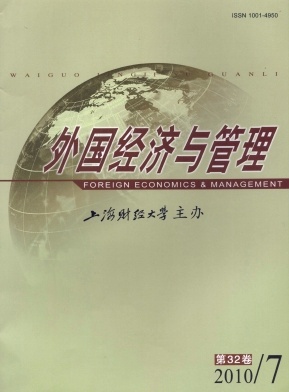上市公司股权激励效应研究脉络梳理与不同视角比较
外国经济与管理 2010 年 第 32 卷第 07 期, 页码:57 - 65
摘要
参考文献
摘要
股权激励是解决委托代理问题的重要工具,但股权激励效应又是一个充满争议的论题。本文从理论基础、研究思路和研究方法等角度出发,把股权激励效应的相关研究归纳为外生视角、内生视角、超外生视角和超内生视角四种研究视角,并以研究视角的演进路径为主线系统阐释了股权激励效应的研究脉络与趋势,然后通过比较这四种研究视角,深入剖析了研究视角演进的合理性和发展的内在逻辑,最后对未来研究进行了简要展望,以期为后续研究奠定扎实的基础。
[1]Jensen,Michael C,and Meckling,William H.Theory of thefirm:Managerial behavior,agency costs and ownershipstructure[J].Journalof Financial Economics,1976,3(4):305-360.
[2]Fama,Eugene F,and Jensen,Michael C.Agency problems and residual clai ms[J].Journal of Law&Economics,1983,26(2):327-349.
[3]Bebchuk,Lucian Arye,and Fried,Jesse.Executive compensation as an agency problem[J].Journal of Economic Perspectives,2003,17(3):71-92.
[4]Morck,R,Shlefier,A,and Vishney,R W.Management ownership and market valuation:An empirical analysis[J].Journal ofFinancial Economics,1988,20(1-2):293-315.
[5]Makri,Marianna,Lane,Peter J,and Gomez-Mejia,Luis R.CEOincentives,innovation,and performance in technology-inten-sive firms:Areconciliation outcome and behavior-based incentive schemes[J].Strategic Management Journal,2006,27(11):1 057-1 080.
[6]Wu,Jianfeng,and Tu,Runtig.CEOstock option pay and R&Dspending:Abehavioral agency explanation[J].Journal of Busi-ness Research,2007,60(5):482-492.
[7]Mak,Y T,and Li,Yuan.Determinants of corporate ownership and board structure:Evidence fromSingapore[J].Journal of Cor-porate Finance,2001,7(3):235-255.
[8]Core,John E,Holthausen,R W,and Lareker,D F.Corporate governance,chief executive officer compensation and firm per-formance[J].Journal of Financial Economics,1999,51(3):371-406.
[9]Jensen,Michael C,and Murphy,Kevin J.CEOincentives─It’s not how much you pay,but how[J].Harvard Business Review,1990,68(3):138-153.
[10]Alessandro,Zattoni,and Alessandro,Minichilli.The diffusion of equity incentive plans in Italianlisted companies:What is thetrigger?[J].Corporate Governance:An International Review,2009,17(2):224-237.
[11]Acharya,Viral V,and Bisin,Alberto.Managerial hedging,equity ownership,and firmvalue[J].Journal of Economics,2009,40(1):47-77.
[12]Bryan,S,Hwang,LeeSeok,and Lilien,Steven.CEO stock-based compensation:An empirical analysis of incentive-intensity,relative mix,and economic determinants[J].The Journal of Business,2000,73(4):134-146.
[13]Murphy,K J.Explaining executive compensation:Managerial power vs.the perceived cost of stock options[J].University ofChicago Law Review,2002,69(3):847-869.
[14]Feng,Yi,and Tian,Yisong S.Option expensing and managerial equityincentives[J].Financial Markets,Institutions&Instru-ments,2009,18(3):195-241.
[15]Dunford,Benjamin B,Boswell,Wendy R,and Boudreau,John W.When do high-level managers believe they caninfluence thestock price?Antecedents of stock price expectancy cognitions[J].Human Resource Management,2010,49(1):23-43.
[16]Volker,Laux.Onthe benefits of allowing CEOs toti me their stock option exercises[J].Journal of Economics,2010,41(1):118-138.
[17]Ward,AndrewJ,Brown,Jill A,and Roadriguez,Dan.Governance bundles,firm performance,and the substitutability andcomplementarity of governance mechanisms[J].Corporate Governance:An International Review,2009,17(5):646-660.
[18]La Porta,R,Loperz-de-Silanes,F,Shleifer,A,and Vishny,R W.Investor protection and corporate governance[J].Journal ofFinancial Economics,2000,58(1-2):3-27.
[2]Fama,Eugene F,and Jensen,Michael C.Agency problems and residual clai ms[J].Journal of Law&Economics,1983,26(2):327-349.
[3]Bebchuk,Lucian Arye,and Fried,Jesse.Executive compensation as an agency problem[J].Journal of Economic Perspectives,2003,17(3):71-92.
[4]Morck,R,Shlefier,A,and Vishney,R W.Management ownership and market valuation:An empirical analysis[J].Journal ofFinancial Economics,1988,20(1-2):293-315.
[5]Makri,Marianna,Lane,Peter J,and Gomez-Mejia,Luis R.CEOincentives,innovation,and performance in technology-inten-sive firms:Areconciliation outcome and behavior-based incentive schemes[J].Strategic Management Journal,2006,27(11):1 057-1 080.
[6]Wu,Jianfeng,and Tu,Runtig.CEOstock option pay and R&Dspending:Abehavioral agency explanation[J].Journal of Busi-ness Research,2007,60(5):482-492.
[7]Mak,Y T,and Li,Yuan.Determinants of corporate ownership and board structure:Evidence fromSingapore[J].Journal of Cor-porate Finance,2001,7(3):235-255.
[8]Core,John E,Holthausen,R W,and Lareker,D F.Corporate governance,chief executive officer compensation and firm per-formance[J].Journal of Financial Economics,1999,51(3):371-406.
[9]Jensen,Michael C,and Murphy,Kevin J.CEOincentives─It’s not how much you pay,but how[J].Harvard Business Review,1990,68(3):138-153.
[10]Alessandro,Zattoni,and Alessandro,Minichilli.The diffusion of equity incentive plans in Italianlisted companies:What is thetrigger?[J].Corporate Governance:An International Review,2009,17(2):224-237.
[11]Acharya,Viral V,and Bisin,Alberto.Managerial hedging,equity ownership,and firmvalue[J].Journal of Economics,2009,40(1):47-77.
[12]Bryan,S,Hwang,LeeSeok,and Lilien,Steven.CEO stock-based compensation:An empirical analysis of incentive-intensity,relative mix,and economic determinants[J].The Journal of Business,2000,73(4):134-146.
[13]Murphy,K J.Explaining executive compensation:Managerial power vs.the perceived cost of stock options[J].University ofChicago Law Review,2002,69(3):847-869.
[14]Feng,Yi,and Tian,Yisong S.Option expensing and managerial equityincentives[J].Financial Markets,Institutions&Instru-ments,2009,18(3):195-241.
[15]Dunford,Benjamin B,Boswell,Wendy R,and Boudreau,John W.When do high-level managers believe they caninfluence thestock price?Antecedents of stock price expectancy cognitions[J].Human Resource Management,2010,49(1):23-43.
[16]Volker,Laux.Onthe benefits of allowing CEOs toti me their stock option exercises[J].Journal of Economics,2010,41(1):118-138.
[17]Ward,AndrewJ,Brown,Jill A,and Roadriguez,Dan.Governance bundles,firm performance,and the substitutability andcomplementarity of governance mechanisms[J].Corporate Governance:An International Review,2009,17(5):646-660.
[18]La Porta,R,Loperz-de-Silanes,F,Shleifer,A,and Vishny,R W.Investor protection and corporate governance[J].Journal ofFinancial Economics,2000,58(1-2):3-27.
引用本文
徐宁, 徐向艺. 上市公司股权激励效应研究脉络梳理与不同视角比较[J]. 外国经济与管理, 2010, 32(7): 57–65.
导出参考文献,格式为:
下一篇:战略创业研究演进与前沿探析





 8460
8460  290
290

